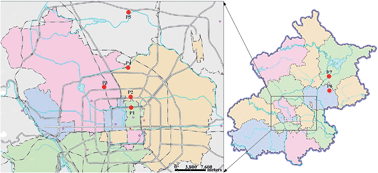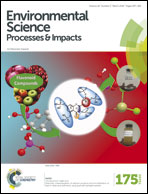Sources of organic matter (PAHs and n-alkanes) in PM2.5 of Beijing in haze weather analyzed by combining the C–N isotopic and PCA-MLR analyses
Abstract
Organic molecular composition and carbon and nitrogen isotope ratios of PM2.5 samples collected in November 2013 were analyzed using gas chromatography/mass spectrometry and isotope ratio mass spectrometry. The samples represented six potential sources and seven sampling sites situated in concentric zones around Beijing under both haze and non-haze conditions. Our results showed that the average concentrations of polycyclic aromatic hydrocarbons (PAHs) and n-alkanes were 258.2 ± 208.8 ng m−3 and 499.5 ± 347.8 ng m−3, while the δ13C and δ15N values for PM2.5 varied from −26.29 to −25.26‰ and from 8.68 to 14.50‰ with an average of −25.70 ± 0.3‰ and 11.97 ± 1.79‰, respectively. The highest concentrations of PAHs and n-alkanes were recorded in the sixth ring road, with the lowest ones in the third ring road. Concentrations of PAHs during haze were higher than during non-haze conditions, while concentrations of n-alkanes were not markedly different. Principal component analysis/multiple linear regression analyses indicated that the main sources of PAHs were vehicle and coal combustion emissions, while n-alkanes had high contributions from petroleum emissions. These sources were supported by isotopic analyses. Thus, the main sources of organic matter contributing to haze in Beijing were coal combustion and vehicle emissions. Such results provide guidance towards managing haze in Beijing.


 Please wait while we load your content...
Please wait while we load your content...